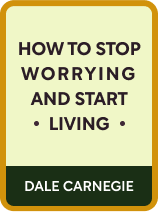

This article is an excerpt from the Shortform book guide to "How to Stop Worrying and Start Living" by Dale Carnegie. Shortform has the world's best summaries and analyses of books you should be reading.
Like this article? Sign up for a free trial here .
Why do we worry? What can you do to stop your mind from drifting into worry and overthinking?
According to Dale Carnegie, worry derives from being outside of the present moment. In his book How to Stop Worrying and Start Living, he presents “thoughtful analysis”—a three-step approach to working through worry by breaking it down into its basic facts.
There are three parts to thoughtfully analyzing and working through worry.
Thoughtful Analysis
According to Dale Carnegie, worry is something you can overcome. The most foundational anti-worry tool is thoughtful analysis. Analysis helps neutralize your emotions and breaks worrisome situations down to their basic facts so that you can look at them clearly and calmly. This allows you to make sound decisions and find the best possible solutions.
Part 1: Get the Facts
It’s important to gather all the information you can about the situation, as this gives full clarity to it. If you’re worrying about something without full information about it, you don’t know exactly what you’re worried about. This can cause you to get stuck on “what-ifs” or make decisions based on false or incomplete information.
When you’re gathering facts, be sure you’re gathering all the information possible. It’s often tempting to only seek out and use information that confirms your thinking, but this prevents you from seeing the situation from all sides and making a fully informed decision. Of course, it can be difficult to remain unbiased—when you’re faced with worry and emotions are high, you’ll naturally reach for information that makes you feel better, even if it’s not completely true. In these situations, there are several methods you can try to look at the problem and accompanying information more objectively:
- Pretend you’re gathering information for someone else who needs to make the decision—this gives you a bit of emotional distance from the matter, and you’re more likely to gather full information for “someone else.”
- Pretend that you’re preparing a case against a lawyer—this forces you to look into all the possible information on the matter, even the information that’s hurtful or makes you feel bad because it could be “used against you” by the other side.
Part 2: Analyze Your Information
Write out all the information you have and lay it out. Information is easiest to sort through when you can visualize it all in one place, so choose a method that allows you to see all your facts at once and is visually pleasing for you—for example, use sticky notes, a whiteboard, or color-coded papers.
Once you’ve looked through all the information, ask yourself:
- What am I worried about? This question brings you to the actual issue at hand.
- What can I do about it? This question leads you to think about solutions to the core problem you identified.
Then, list all the possible solutions to your problem and decide which will have the best possible outcome.
This process of analysis is important because you get directly to the center of your problem and choose a clear direction to move in—instead of getting overwhelmed by information or caught in a spiral of “what ifs.”
Part 3: Act on Your Decision
Once you come to a decision, start acting on it. It’s crucial that you start acting on your decision right away so that you don’t have time to second-guess yourself or worry that you’ve made the wrong decision.
Keep in mind that taking action doesn’t necessarily mean solving the problem all at once. It simply means that you should start on what you can do immediately.
- For example, if your doctor tells you that you’re pre-diabetic and you decide to take charge of your health, it’s unlikely that you’ll be able to change your lifestyle right away. However, you can start cutting soda out of your diet immediately.
Shortform Example: Navigating a Financial Tight Spot
One month, you find yourself in an especially tight financial situation. You start worrying—“What if my landlord evicts me?” “What will I do if I can’t afford food in a few weeks?” “What if my power gets cut off?” “What if I unexpectedly lose my job?”
You decide to analyze your situation and figure out how you can make it through the month. You start by gathering relevant information: You make a spreadsheet of your bills and their due dates, you examine last month’s spending and create a budget, and you collect information about the repercussions of missed payments for each of your bills.
You ask yourself, “What am I worried about?” You determine that you’re worried that you won’t be able to cover your most necessary expenses like rent, food, and electricity. You come up with a list of possible solutions:
- Borrow money from family or friends to cover your bills.
- Pay all your bills in full, but have next to nothing left over for food.
- Put money aside for food, pay some of your most important bills, and deal with late fees on the others later.
- Put aside money for food and pay all your bills in full except your credit card bill.
You review your information about missed credit card payments and see that there’s a special payment system you can use in case of financial difficulty. You decide that this is the best course of action and call your credit card company to explain your situation. They waive this month’s minimum payment so you won’t get a late fee and put you on a payment plan for the next four months so you can catch up on the bill bit by bit.
Without the credit card bill to think about, you’re able to cover all your other expenses for the month, avoid numerous late fees, and get back on your feet.
How to Apply Worry Analysis to Your Organization
A lot of stress and worry in businesses is caused by unnecessary meetings that talk around issues but don’t productively dig into problems and their solutions. You can make these meetings more productive and reduce stress in your workplace by making sure you’re asking the right questions—those that spark analysis and action.
Step 1: Information-Gathering Questions
What’s the problem? This question is important because a lot of time is wasted in meetings when people don’t actually know what problem they’re facing.
What’s the source of the problem? This question is important because many meetings that discuss problems end without actually finding the root of the problem—which is where solutions should be aimed.
Step 2: Analysis Question
What are all the possible solutions? This question is important because it specifies that numerous suggestions are encouraged. On the other hand, when you ask about “the” solution, it feels that only one suggestion can be important. This drives people to become competitive and refuse to listen to one another.
If you don’t make it clear that you want to hear every idea, you’ll end up spending your time refereeing arguments about whose solution deserves discussion, instead of focusing on the problem at hand.
Step 3: Action Question
What’s the best solution? Make sure that once all the possible solutions are written down, you decide on a solution and start taking steps to put it in motion. Don’t get caught up in endless consideration of the different solutions’ outcomes.
Teaching members of your organization to follow these steps when facing a problem reduces your stress and worry in several ways.
- Team members won’t come to you with problems so frequently—going through the process of analysis forces them to consider facts and solutions, which often results in them solving the problem on their own.
- When they do need your help finding a solution, the discussion takes significantly less time, as they’ve gathered and prepared all the relevant information ahead of time.
Analyzing Worry in an Emergency
Naturally, some anxiety-inducing situations crop up in life unexpectedly and you won’t have time for thorough analysis. In these situations, when all you can do is wait for the outcome, you’ll need a quick way to stop your worry from spiraling out of control. There’s a three-step process to put an “emergency stop” on worry.
1) Determine what the worst possible outcome would be. List all the possible outcomes of the issue—keep going until you arrive at the worst possible outcome.
- For example, if you made a major mistake with the accounts at work and lost $500,000, your worst possible outcome would probably be getting fired.
2) Mentally prepare to accept the worst outcome. Once you have this outcome in mind, mentally accept that it’s going to happen, instead of trying to convince yourself it won’t. This spurs you to shrink your focus to how you’ll deal with the aftermath.
- If you imagine that you’ll lose your job, you might think, “I have a lot of experience in this field, so I can probably find a new job without too much trouble.”
3) Try to make the situation better. Once you’ve accepted the worst outcome and considered how you’ll deal with it, you can focus your energy on finding ways to mitigate your current situation as best you can.
- You might examine your organization’s budget to find reasonable places to cut back and recover the $500,000 over a relatively short amount of time.
When you’re worried, your judgment tends to become cloudy and panicky—you become lost in thoughts of everything that could happen. By forcing you to consider and accept the worst, this exercise clears your thinking so that you can more effectively find immediate solutions to your problem.

———End of Preview———
Like what you just read? Read the rest of the world's best book summary and analysis of Dale Carnegie's "How to Stop Worrying and Start Living" at Shortform .
Here's what you'll find in our full How to Stop Worrying and Start Living summary :
- What worry is and how it manifests both physically and mentally
- How to deal with worry about work, finances, and criticism
- How to cultivate a less worried mindset







Hi, I have signed up for a free trial but I still can’t read the entire book summary. What should I do?
Hi Johnson! I reached out over email to let you know you can access the full book guide here.